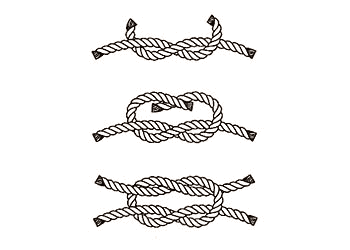 Let's take the Square Knot as an example. Notice the symmetry of this knot. It is very easy recognize if it is tied correctly.
Let's take the Square Knot as an example. Notice the symmetry of this knot. It is very easy recognize if it is tied correctly.
 The Granny Knot Now lets compare this properly tied knot to the Granny Knot which is the most common way to incorrectly tie the Square Knot.
The Granny Knot Now lets compare this properly tied knot to the Granny Knot which is the most common way to incorrectly tie the Square Knot.
The Square Knot is much stronger than the Granny Knot and is much easier to untie when no longer needed. Both of these traits are exactly what we desire in a great knot.
Some other characteristics of great knots are the ease in tying, a great example is the simple and very versatile Figure Eight Knot. Often, we are interested in reliable knots that are also easy to untie when we are finished. A tensionless hitch is a good example. Minimal rope use can be desirable as well. The water knot used to tie webbing is very concise and works exceptionally well.
The following article from a caving organization provides some great evidence on rope strength and why proper tying of knots is so crucial: Article on Rope/Knot Strength. Good takeaways from this article are:
- Proper knot selection often means the difference between 50% strength loss versus 20%
- Improperly tied knots fail prematurely under load
- Backing knots are very important when your line is under load
- The old rule of thumb, 50% strength loss isn't a bad rule of thumb for us to use for maximum load estimations
